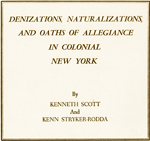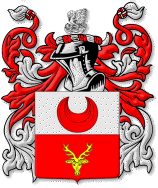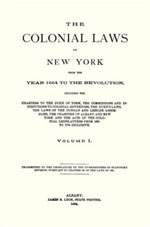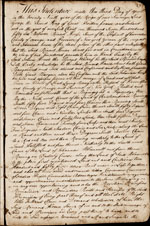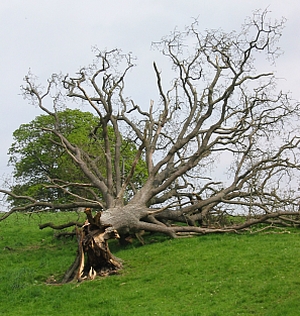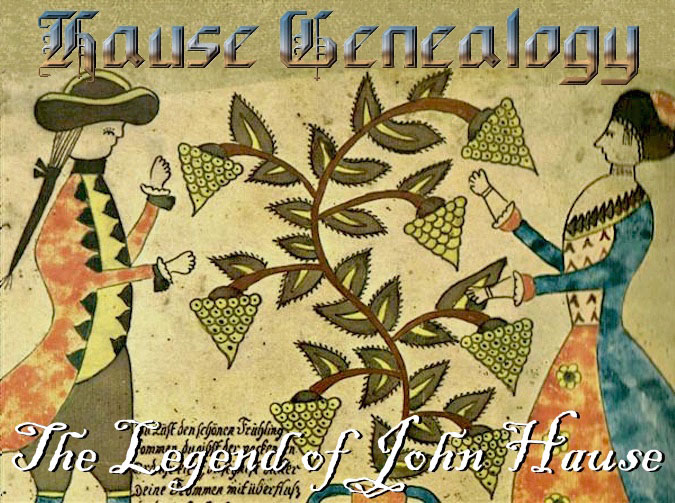 |
"The first John Hause was born in Germany in the year 1690, and when an infant, on account of Religious Persecutions, he was transported by his 'cousin', Queen Mary II, of Great Britain, House of Stuart, Daughter of James II and Anne Hyde, born 1662, married William, Prince of Orange at the age of 17, reigning 15 years, and died in 1694 of Small Pox, leaving no children. A kind, meek, and noble Queen."
—Sketch compiled by Alfred Hause in 1904, based on notes by Lewis K. Hause and the Family Bible of Joseph Hause of Ovid, New York.
|
||||||||||||||||||||||||||
|
||||||||||||||||||||||||||||||
"The family of Hawes, or Hause at it is quite often spelled, is one of the few in our country which have a matter of record genealogy extending far back in the centuries. Through the efforts of Alfred B. Hause of Ovid and Dr. James Hause of Valois the family line has been carried back to 1690 when the John Hause to whom they trace was an infant born in Germany and cousin of Queen Mary II of Great Britain."
—"Watkins Express", Watkins Glen, Schuyler, NY, 21 Jul 1904.
|
My family had never really talked about its origins. In fact, here was the sum total of our knowledge: My father had been told by his father's father (my great-grandfather) that a Hause ancestor was the first sheriff of Jamestown,² another wrote Bible hymns (this turned out to not be a Hause, after all, but was my great-great grandfather William Henry Marchant), and that another ancestor had died from leaning too far back in his chair, when the wooden backing snapped and pierced his heart as he crashed to the floor (which I was pretty sure was just an invented story to keep me from leaning back in my chair at the dinner table). Other than that, I didn't know the names of any Hause ancestors beyond that same great-grandfather, who had just passed away, and obviously couldn't fill me in as to anybody else's identity.
|
But as to the accuracy of this cousin theory, after years of family research, I can now conclude... that I'm not the first writer in my family to work in fiction.
"The Doctor has had the genealogy of the Western New York branch put in print for distribution among his kinsfolk of the name."
—"Watkins Express", Watkins Glen, Schuyler, NY, 21 Jul 1904.
|
"As far as can be traced John Hause is the first of the family that can be found it is ascertained that he was a German of full blood and that the correct orthography of his name was H-a-u-s-e."
—Lewis K. Hause, quoted @ 1850 in a letter from Alfred Hause to James D. Hause, 28 Jan 1904.
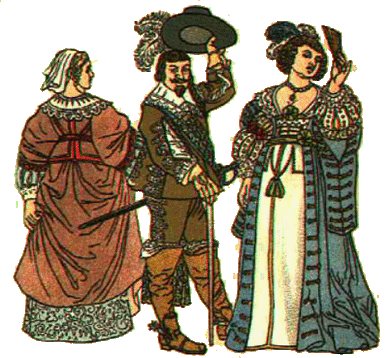
|
Queen Mary was also the great niece of Elizabeth Stuart (19 Aug 1596 - 13 Feb 1662), who had been the "Winter Queen" of Bohemia and the Palatinate, and whose in-laws were Frederick IV and Louise Juliana of Nassau; Mary was even a cousin to the Dukes of Solms, through her marriage to William III of Orange. Because of this, many family genealogists have concluded that John Hause was actually named Johannes Hauß, a son of Palatine immigrant JOHANN CHRISTIAN HAUß.¹ Johannes would have been born around 1690 in Großaltenstädten, Solms-Hohensolms, and traveled to the New World with his father and siblings. It makes sense because Großaltenstädten is now part of Germany, just like the legend, and "Johannes" is a German equivalent of "John." As for the difference in the spelling of the last name, the Hauß name was (and still is) subject to many spelling variations in English, because there's no letter equivalent to "ß." The name was therefore anglicized by British Colonial clerks and census takers as "Haub," "Hauss," "Haus," "House," and, in English-speaking areas like Haverstraw, "Hawes" and "Hause." (There were even multiple variations in the Palatinate.)
Because the spellings are so arbitrary, it's impossible to connect our line to a particulor ancestor by name alone. We could be from any of these:
German Line⁴ |
French/Norman Line⁵ |
British Line⁶ |
|
||||||||||||||||||||||||||
How do we get "Simon" to fit into the legend of John Hause? Well, his birth date is about right, and in documents from his home country, he was named "Johann Simon Haas." Johann is the Germanic derivation of "John." This is important because in the Holy Roman Empire, boys were almost always baptized with the first name "Johann" (or "Johannes," abbreviated "Joh"). German girls were baptized as "Maria," "Anna" or "Anna Maria." This means a family could have multiple Johanns and Anna Marias. This is very confusing until you understand that the first name doesn't mean a thing. It's just a formal term like "mister" or "miss." The second name, known as the Rufname, along with a surname ("Haas," in Simon's case) is what would be used in marriage, tax, land and death records. So while he was Johann (John) Simon overseas, in America he was just Simon. If he is actually our immigrant ancestor, then Simon's son JOHANNES HAAS, who was baptized in New York on 11 Nov 1716, according to New York Churchbooks (New York City Lutheran, Vol I, Book 85) would be the first real "John" in our line.
Interestingly, derivations of his name in early Colonial records include "Hawes" and "Haus." Many of his Simon's known descendents spell their name "Hawes" just like many of the lines in our family. Also, the name Simon popped up frequently as a first name in our family history—almost as much as John. (However, the names of Simon's other children, NICHOLAS, and ZACHARIAS, do not. Ever. They just disappear after this generation, which when you go by Palatine naming practices in the 18th Century would seem to be pretty unlikely to happen.) Still, it is another family living in the area of New York and New Jersey whose name can be spelled "Hawes," so they are just as likely to be our ancestors as anybody else.
One way to provide true evidence of John's (and our) connection to one of these lines would be through genetics. The yDNA of all male descendants of John Hause should be nearly identical over the 10-12 generations that have passed since he lived. My yDNA matches perfectly with male descendants of William Hause (going back nine generations), but as of this date, none of the William Hause descendents match up genetically with male descendants of Johann Christian Hauß.¹ There is no DNA data for the line of Simon Haas (I've found several proven descendents and tried to get them to take a yDNA test, but so far I've had no luck). If Simon doesn't match, then John Hause was adopted, or had a different father, or was from another family entirely...
... But let's move on from that before my head explodes. Let's just talk about who John Hause was, and the time and area in which he lived.
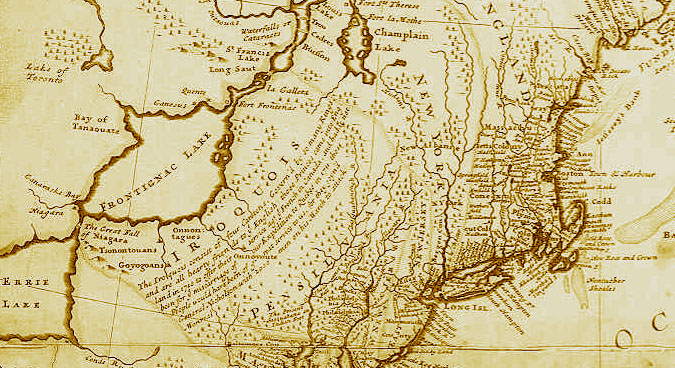 |
"John Hause, born 1690, lived in New York until his marriage in 1715 to Sarah Allen, a woman of fine English Blood. After his marriage, he removed to Haverstraw, Rockland Co., New York."
—From the Genealogy of John Hause Descendants, compiled by Alfred B. Hause in 1904.
|
|
|
According to other family histories, John and Sarah raised six children, which was actually a small amount of kids for a woman to have at the time. This was because men outnumbered women six to one in some colonies. With so few women and so many men, almost all of the women married very early. This extended the years in which women could bear children, and so they could expect to bear an average of eight. Sarah got off relatively light:
CHILDREN OF JOHANNES HAUS AND SARAH ALLEN |
The John Hause legend has John and Sarah moving to Haverstraw, in southeastern New York, north of the New Jersey-New York border, west of the Hudson River, after 1715. While remote, the village of Haverstraw was one of the first to appear on maps of North America, listed in 1616 as Haverstroo, a Dutch word meaning "oats straw," referring to the grasslands along the Hudson River.
Early attempts to settle the county by the Dutch had been unsuccessful, and in 1664 they handed the territory over to the English. In 1686, the Duke of York, later to become King James II of England, established the county system and designated the area as "Orange County." From 1686 till 1719, the present town of Haverstraw was included in the laws, taxes and militia duties of Orangetown. The only courthouse was in Tappan built in 1691 in Tappan with a jail, a whipping post and stocks in the green, and a stray cattle pound. But that area of Haverstraw was increasing so rapidly in population, the distance was so great and the trail so poor between it and Tappan, that the inhabitants petitioned for separate existence. On June 24, 1719, the following act was passed: " An Act to enable the Precincts of Haverstraw in the County of Orange, to chuse a Supervisor, a Collector, two Assessors, one Constable, and two Overseers of Highways."
There had been just 439 inhabitants living in in the area in 1712, but under British rule the population increased dramatically to 1,969 by 1731. Whether Johannes was a carpenter, farmer or miller—the three strongest trades in the area—is unknown (although you had to be proficient at all three to survive a winter in that area). Travel was largely confined to Indian trails by land and sloops by the Hudson River. The Ramapo Mountains were hard to cross, and it would be many years before adequate roads could be built. But considering that Johannes was raised in the Rhine region of the Palatinate, he was probably better prepared than most to work in that environment. The children were home-schooled, at best. The only school house was far away in Tappan, and there would not be another school in the county until late in the 18th century.
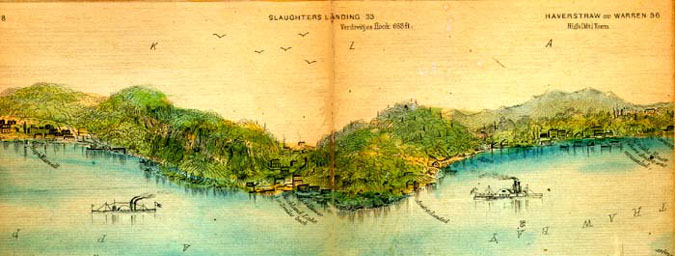 |
"A Johannes Haus was naturalized August 27, 1721 and we have no further record of him."
—"The House Family of the Mohawk," by Melvin Rhodes Shaver. Publisher: St. Johnsville: Enterprise, 1933. Chapter 1, Page 4
|
||||||||||||||||||||||||||||||||||||
A "Johannus Hausz" was Naturalized in New York as a citizen of the British Empire on July 27, 1721. This meant he could now buy and sell land. (With British citizenship and an English wife, it's no wonder that later descendants assumed the Hause family was completely British.)
But beyond that record, the lack of historical documentation for Johannes (or John) is glaring: There's no marriage record of him with Sarah Allen in Haverstraw (or any record of an Allen family, for that matter); There are no deeds, no church baptisms... and that naturalization record is just as likely to be another "Johannes House," (or in one translation, "Hose"), who married Annetje Crose in 1721 in New York City.⁹ Beyond that, there's no record when there should be: Johann Christian Hauß and son, Johann Rheinhardt Hauß, are both recorded in Governor Hunter's subsistence records that kept track of all the indentured Palatines, but not any Johannes. Hunter was very careful about those records, as he expected repayment per head for any and all expenses that the Hauß family would have incurred. If there was another son as old as Rheinhardt (and he would have to be in order to marry in 1715, like Rheinhardt did), his name should have appeared somewhere on those lists.
Still, it has to be remembered that the records of Haverstraw are mostly lost,¹⁰ so even with all this evidence (or more precisely, the lack of evidence), I'm not prepared to say the family Bibles are wrong. There really were Secord and Conklin families living in the area, and they supposedly allied with the John Hause family through marriage to his children (although I can't find any records of those marriages, either⁸). On the other hand, the Conklins and Secords were heavily allied with the Wood family, and intermarried throughout the 18th Century. Martha Wood, who married John's grandson, our ancestor William E. Hause, had a sister, Susanna, marry a Conklin, and a brother, Joseph, who married a Conklin and a Secord, so the families are obviously close. Our first confirmed ancestor, William, did in fact fight alongside Secord and Conklin in his militia in the Revolution, but there's no mention anywhere of them being related. But answering these questions is going to take a little more research, a few new discoveries, and a lot of luck to solve. (See "False Leads and Myths.") But here's a possible clue:
|
|||||||||||||||||||||||||||||||||||||||||||||||||||||||||||||||
Above are the minutes from a Haverstraw town meeting on 3 Apr 1756, showing a sale of land from Rheinhardt House, Sr., to a Johannes House, followed by the minutes from exactly 14 years later, on 3 Apr 1770, in which a "John Hause" was named highwaymaster for a road running to "the mountain," at the end of the town's jurisdiction, next to the Conklin family.¹¹ Are "Johannes House" and "John Hause" the same man? Or were they just neighbors in Haverstraw whose names were confused by family genealogists in the 19th and 20th Centuries? Johannes Hauß, son of Johann Christian Hauß, would have been about 80, according to most genealogists, so is this man in 1770 his son, or the son of his brother Rheinhardt Hauß, making him about 50? Or was he the Son of Simon Hawse, born in 1716? Or was he somebody we haven't even discovered yet? Is he this man, who was renting land in Ramapo, on the New York/New Jersey border in 1756, near his brother (or son), Simon? WHO IS JOHN HAUSE?
The next chapter is the biography of a man who I can confirm existed, without a doubt, even if I can't say who or where he came from... the first generation in our Hause line...
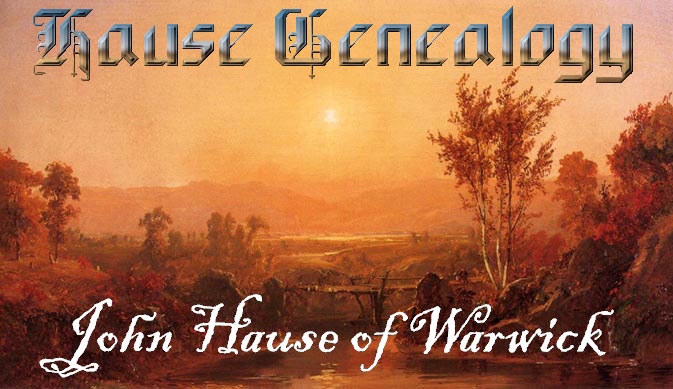 |
CHAPTER TWO: JOHANNES (JOHN) HAUSE, 1719 (1726) - 1796. Our next ancestor is the first in our line to be born in America. PLUS: William, Revolutionary War hero, of Hause Hill.
TOP ILLUSTRATION: "Spring Blessing" (1785): The return of spring is celebrated in this decorative fractur, the term used to designate illustrative records of the Palatines.
NOTES ON THIS PAGE:
¹—An interesting theory concerning the "cousin" story was proposed by family historian Charles Hause (24 Nov 1913 - 30 Mar 2002), who spent decades trying to uncover the identity of "John Hause." Charles wrote in a 1963 letter, now in possession of Bob and Shirley Hause of Kansas: "Of John Hause, it has not yet been proved for sure that he hooks up to the rest of the Hause's as we cannot find out for sure the father's name of William Hause, Sr. It is believed that a generation is missing between John and William, and if it can be located perhaps this will hook the two together. Also, a story brought down through the family, is that the Hause's came from Germany with a group of others. They possibly bore the name of Von Ackenhausen, which if true means that they were of the gentry to use and (sic) English expression. Also, the German gentry made use of two names, one representing the family, and the other the House to which they belonged. So, if the family traditions are truth, and that the Hause's left Germany in the 1690's to escape religious persecution, then the family probably came from the Rhine Valley, and most likely from the area east of the river which was taken over at the time by France under King Louis the 14th. In following up this theory, the name has been found among the Nobility of the area, particularly in Alsace."
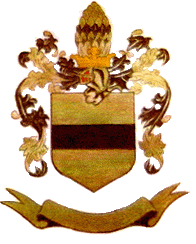 Charles eventually tried to tie the John Hause legend to the story of Palatine immigrant Johann Christian Hauß. He speculated that Johann Christian Hauß was from the Alsace region of France, and had fled to the Duchy of Solms during the Thirty Years War.⁵ (Footnotes for footnotes? Oh yeah, that's how I roll.) He wrote in a 1969 letter: "The family of Johann Christian Hauss was Armigerous, and the traditions of both branches agree on the Heraldic Bearing; an Argent Shield with a Sable Fesse; the Crest a Plume of featherstinctured as the shield and in the form of a pine-cone, this surmounting a Peer of the Realm Crown borne by a dexter facing, Argent and Sable Helm. These Arms are in Reitstap's 'Armorial General' and are attributed to Haus-Alsace. An earlier version (dating back to 1185) of the same shield and with a feather plume in the pine-cone shape on a Knight's Helm is in Die Wappen Rolle Von Zurich. (A Roster of Heraldry of Zurich, by the Antiquarian Society of Zurich.) Here several spellings of the name are given. The family again is Alsatian and is known in Switzerland as Von Hus, in Italy as de Domo, France as de la Maison and in Germany as Von Hauss or Von Haus; these names being derived from the Burgen (Castles or Strongholds) of Isenheim in the District of Gebweiller; Wittenheim (District of Mulhouse); and Wassenberg (District of Kolmar). All were of Alsace, now of the Haut Rhin in France.All are north-northwest of Mulhouse. A coincidence or food for thought? The Dukes of Solm held territory not more than fifty miles from the Haus holdings in Alsace above. Frederick Henry, Prince of Orange 1584-1647 m.Amalia, Countess of Solms Braunfeld. son William II of Nassau, 1626-50, m. Henrietta Mary Stuart, dau of James II of England. son William III, Prince of Orange, 1650-1702, m. Mary Stuart, dau of James II of England (this was Queen Mary.) William III was raised after he lost his mother at age 10, by his paternal Greatgrand (sic) mother Amelia, Princess of Solm. After his defeat by the Armies of Louis XIV, Johann Christian Hauss found refuge in Alten-Staeden, near Wetzlar, in the Duchy of Solm. Could this be the source of the term Cousin in the Hause tradition?" Charles believed that the line looked like this:
Charles eventually tried to tie the John Hause legend to the story of Palatine immigrant Johann Christian Hauß. He speculated that Johann Christian Hauß was from the Alsace region of France, and had fled to the Duchy of Solms during the Thirty Years War.⁵ (Footnotes for footnotes? Oh yeah, that's how I roll.) He wrote in a 1969 letter: "The family of Johann Christian Hauss was Armigerous, and the traditions of both branches agree on the Heraldic Bearing; an Argent Shield with a Sable Fesse; the Crest a Plume of featherstinctured as the shield and in the form of a pine-cone, this surmounting a Peer of the Realm Crown borne by a dexter facing, Argent and Sable Helm. These Arms are in Reitstap's 'Armorial General' and are attributed to Haus-Alsace. An earlier version (dating back to 1185) of the same shield and with a feather plume in the pine-cone shape on a Knight's Helm is in Die Wappen Rolle Von Zurich. (A Roster of Heraldry of Zurich, by the Antiquarian Society of Zurich.) Here several spellings of the name are given. The family again is Alsatian and is known in Switzerland as Von Hus, in Italy as de Domo, France as de la Maison and in Germany as Von Hauss or Von Haus; these names being derived from the Burgen (Castles or Strongholds) of Isenheim in the District of Gebweiller; Wittenheim (District of Mulhouse); and Wassenberg (District of Kolmar). All were of Alsace, now of the Haut Rhin in France.All are north-northwest of Mulhouse. A coincidence or food for thought? The Dukes of Solm held territory not more than fifty miles from the Haus holdings in Alsace above. Frederick Henry, Prince of Orange 1584-1647 m.Amalia, Countess of Solms Braunfeld. son William II of Nassau, 1626-50, m. Henrietta Mary Stuart, dau of James II of England. son William III, Prince of Orange, 1650-1702, m. Mary Stuart, dau of James II of England (this was Queen Mary.) William III was raised after he lost his mother at age 10, by his paternal Greatgrand (sic) mother Amelia, Princess of Solm. After his defeat by the Armies of Louis XIV, Johann Christian Hauss found refuge in Alten-Staeden, near Wetzlar, in the Duchy of Solm. Could this be the source of the term Cousin in the Hause tradition?" Charles believed that the line looked like this:
| Johann Christian Hauß > | / Johannus Hausz \ m. Sarah Allen |
> | / John Hause (b. 1719) \ m. Sarah Wheeler |
> | / William Hause (b. 1750) \ m. Martha Wood |
Family historians such as Josephine Gregory and Doug Deal eventually agreed with this theory, but Charles began to question this, as well. In a letter to Bob Hause dated Nov. 27, 1991, Charles was convinced of a different theory and wrote: "Did have a correspondent dispute our descent from the 2nd John Hause and Sarah Allen, saying instead that our third John (who married Sarah Weiler) was the son of his brother Reinhard, and Anna Marie Gussinger. (They did have a son John Hendrick who was born in Yonkers, N.Y. on May 15, 1715 and was baptised at Hackensack, N.J. on May 8, 1722.) So possibly he does have the correct data there, and our lineage should read: John Christian Hause, m. (unknown 1st wife); Reinhard Hause m. Anna Marie Gussinger; John Hause m. Sarah Weiler; William Hause m. Martha Wood; William Hause married Esther Sanford and so on."
|
|||||||||||||||||||||||||||||||||
Rheinhardt was Naturalized on 10 Jan 1715/16, and listed his occupation as "yeoman." He then moved to Philippsburg, Westchester, New York, near the area called Sleepy Hollow, even attending the very Dutch Reformed Church of Washington Irving's story. They had several more children: Anna Juliana (b. 5 Feb 1718), Susanna (b. 9 Apr 1720), Jannitje ("Janet"), and Christian (b. 2 Aug 1721). Another son, Johannes Haus, was baptized at 9 weeks old, on 29 May 1726, to parents "Reinhard Haus and his wife, Anna Elisabeth."
Johannes then married Sara Wheeler, from a prominent family based in Kinderhook, Columbia County. Sara was baptized on 28 Aug 1728 at the Reformed Church, in Kinderhook, to "Jan Wieler" and wife Margariet. Unlike the various John Hause families in our family lore, the Johannes Haus/Sarah Wheeler family is very well-documented through church records on the border of New York and New Jersey—you just have to be patient and check EVERY spelling variation. (In those days with few schools and no formalized language, the spelling of names was usually done phonetically, so Johannes's last name often changed from "Haus" to "Haas" to "Haws" to "Hauss" to "Howes" to "Huus" to "Huis" to "Hous" to "House" to "Huyser" to, finally—"Hause"—for the christening of daughter Marritje in 1750.
By 1750, Johannes had moved to the area of Haverstraw with father Rheinhardt and brother Rheinhardt, Jr.: the very location of the John Hause and Sarah Allen family legend. Their first child, Elisabeth, was christened 10 May 1747 at the Reformed Church in Tappen, Rockland, New York, with sponsors "Ryndert Houys" and wife, Elizabeth. More children followed, recorded in church ceremonies in Kakiat, Orangetown and Clarkstown. Then on 24 Feb 1750/51, "Willem Haas" was born to "Johannes Haas and wife Sarah," according to baptism records of the New York City Lutheran Church (Holland Society of New York; New York; New York City Lutheran, Vol I, Book 85, p. 361). That is the exact date of birth that is listed on the D.A.R. plaque at the grave of our ancestor William Hause (1750-1818).
So now Charles believed that the family line would be this:
| Johann Christian Hauß > | / Johann Rheinhardt Hauß \ m. Anna Elisabeth |
> | / Johannes Haus (b. 1728) \ m. Sarah Wheeler |
> | / William Hause \ m. Martha Wood |
Not only is the Johannes Haus family in the proper area to match our records, everything seems to fit perfectly into the timeline of the legend, as well. Johann Rheinhardt was born around 1690, like John Hause; Johann Rheinhardt married in 1715, like John Hause; He had a son named Johannes/John in 1726. There was just one problem: Genetics.
To settle the matter of my Hause ancestry once and for all, in December of 2014 I took a Y37 DNA test with FamilyTreeDNA to check my paternal line. My Y-Chromosome DNA (Y-DNA) would trace my father, his father, his father's father, and so forth, as it is goes largely unchanged for centuries. This would prove, scientifically (and conclusively) that I was a direct descendant of Johann Christian Hauß... or that the genealogical work of countless ancestors and cousins was incorrect and I was descended from someone else... or that there was some hanky-panky along the way by one of my maternal ancestors (not counting you, mom, of course). Whatever the case, I would finally have hard, scientific evidence as to whether or not I am a true biological Hauß, or a Hawes, or a Haws, or a House, or... my head hurts. (Just take the damn test already!) So Bob Hause and I submitted buccal swabs for a YDNA test to compare with eight descendants of Johann Christian Hauß (actually seven, because one would only claim to go as far back as his son, Conradt), and prepared (over the next eight loooooong weeks) to either confirm what had been assumed by all of these genealogical histories... or to undertake a quick, massive rewrite of THIS family history before anybody else could read it... And here are the results, with matching markers in white (I'll only show the first twelve STR markers):
| Ancestor | Haplogroup | DYS393 | DYS390 | DYS19 | DYS391 | DYS385 | DYS426 | DYS388 | DYS439 | DYS389i | DYS392 | DYS389ii |
| Jeff Hause, U.S. | I-M223 | 14 | 23 | 15 | 10 | 14-16 | 11 | 13 | 11 | 14 | 12 | 32 |
| Bob Hause, U.S. | I-M223 | 14 | 23 | 15 | 10 | 14-16 | 11 | 13 | 11 | 14 | 12 | 32 |
| Johann Christian Hauß, (House) | R-M269 | 12 | 25 | 15 | 10 | 11-14 | 11 | 12 | 13 | 13 | 13 | 29 |
| Johann Christian Hauß, (House) | R-M269 | 12 | 25 | 15 | 10 | 11-14 | 11 | 12 | 13 | 14 | 13 | 30 |
| House (b. 1740), (House) | R-PF7563 | 12 | 25 | 15 | 10 | 11-14 | 11 | 12 | 13 | 14 | 13 | 30 |
| Johann Christian Hauß, (Howes) | R-M269 | 12 | 25 | 15 | 10 | 11-14 | 11 | 12 | 13 | 14 | 13 | 30 |
| Conradt A House, (Schramm) | R-M269 | 12 | 25 | 15 | 10 | 11-14 | 11 | 12 | 13 | 14 | 13 | 30 |
| Johann Christian Hauß, (House) | R-M269 | 12 | 25 | 15 | 10 | 11-14 | 11 | 12 | 13 | 14 | 13 | 30 |
| Johann Christian Hauß, (House) | R-M269 | 12 | 25 | 15 | 10 | 11-14 | 11 | 12 | 13 | 14 | 13 | 30 |
| Johann Christian Hauß, (House) | R-M269 | 12 | 25 | 15 | 10 | 11-14 | 11 | 12 | 13 | 14 | 13 | 30 |
|
| ?????? ????????? ????? > | / ????????? ????? \ m. ???? ?????? |
> | / John ??????? \ m. Sarah ??????? |
> | / William Hause \ m. Martha Wood |
²—In this author's line, Carleton Marchant Hause, Jr., remembered his grandfather, Carlisle Hause, sitting him down along the bank of Vaughn Lake in upper Michigan and telling him the family's whole history. Being young, distracted, and wanting to fish (kind of the way he stayed until he passed, seventy years later, in 2014), Carleton didn't listen to his grandfather much that morning, and recalled practically nothing. But what he did remember is that Carlisle showed him a tablet written by Melissa Hause (it's now lost, but it was much like this one, kept by another relative). Carlisle also told him that a Hause had been the first sheriff in one of the Pilgrim colonies of Massachusetts—he thought Carlisle said "Jamestown."
Well, it turns out that Carlisle—being a Hause and, therefore, incredibly smart—was right... sort of. There is an English branch of Hause (or Hawes) family, and it's a common surname in England. If that isn't strange enough, Carlisle was also right that a man named Edmund Hawes was the first Pilgrim Constable of the Plymouth colony of Duxbury in Massachusetts, starting in 1642/3, and serving well into the 1650's. Was Carlisle right?
To settle the matter of my Hause ancestry once and for all, in December of 2014 Bob Hause and I submitted buccal swabs for a YDNA test to compare our Y-DNA with three descendants of Edmond Hawes, and prepared (over the next eight loooooong weeks) to either confirm or deny what Carlisle only hinted at... And here are the results, with matching markers in white (again, I'll only show the first twelve STR markers):
| Ancestor | Haplogroup | DYS393 | DYS390 | DYS19 | DYS391 | DYS385 | DYS426 | DYS388 | DYS439 | DYS389i | DYS392 | DYS389ii |
| Jeff Hause, U.S. | I-M223 | 14 | 23 | 15 | 10 | 14-16 | 11 | 13 | 11 | 14 | 12 | 32 |
| Bob Hause, U.S. | I-M223 | 14 | 23 | 15 | 10 | 14-16 | 11 | 13 | 11 | 14 | 12 | 32 |
| Edmond Hawes, (Hawes) | I-M253 | 14 | 22 | 14 | 10 | 13-13 | 11 | 16 | 11 | 12 | 11 | 28 |
| Edmond Hawes, (Hawes) | I-M253 | 14 | 22 | 14 | 10 | 13-13 | 11 | 16 | 11 | 12 | 11 | 28 |
| Edmond Hawes, (Hawes) | I-M253 | 14 | 22 | 14 | 10 | 13-13 | 11 | 16 | 11 | 12 | 11 | 28 |
Nope, Sorry, Carlisle. The Haplogroup for three people claiming to be descendants of Edmond Hawes is I-M253, from the same Y-chromosome Haplogroup "I," which includes about a quarter of all northwest European men. Its largest subgroup, I1a, is common in Scandinavia and Germany and occurs in Britain at a frequency of about 15%. However, there is some controversy as to whether I-M223 should properly be considered a subgroup of Haplogroup I1, or a separate Haplogroup I2 (I2b1 lineage), which likely has its roots in northern France. Beyond that, we only match in four out of the first twelve markers, and I only match in 11 out of 37 STR markers, overall, with these Hawes progeny. This means we are NOT actually related! (We haven't had a common paternal ancestor for about 18,000 years, anyway.)
It should be remembered that Carlisle's grandfather, Laban Hause, couldn't even remember any Hauses past his grandparents (who he didn't know), so much of what he or anybody else came up with in our line at that time would have been from rudimentary research—or just flat-out speculation. The world was a lot smaller then. Everybody at that time thought "Hause" or "Hawes" was a rare surname—and didn't realize there were thousands upon thousands of people out there with the same name, but from different lineages. So Carlisle basically had no family history to go on, and was speculating from what facts he could find. How Carlisle came up with this information is impossible to guess. Today, hundreds of family genealogists have spent years building a huge electronic database that we can draw from, including DNA evidence. Previous generations had to guess at our origins from a much more limited pool of data.
Looking through the various worksheets and genealogies by people in our family over the last two centuries, our family records are split between ancestors saying we are German (most of them), and the other, smaller contingent saying we're British:
|
EVIDENCE THAT WE'RE ACTUALLY BRITISH:
|
EVIDENCE THAT WE'RE ACTUALLY GERMAN:
|
At least thanks to our Haplogroup, I-M223 (also known as I2a2), we know we're European. The first man to be I-M223 (let's call him Proto-Hause) probably lived in Europe about 14,000 to 18,000 years ago—in the age of the Cro-Magnon, near what is now northern France. We know from DNA evidence that his ancestors had avoided the boorish Neanderthal family who lived down the street, and stuck to their own. (Who knows, maybe they dated, but nothing came of it.) Proto-Hause's father was not in Haplogroup I-M223, nor were any of his brothers. They were all in Haplogroup I-M170. Proto-Hause was "special:" A sperm from Proto-Hause's father had a Y-chromosome that mutated, and it fertilized his mother's egg at his conception, and the I-M223 "family" was created in that moment—before there were Germans, or Britons, or even Hause's—making Proto-Hause's descendants different than everyone else on Earth. (And definitely different than Edmond Hawes's and Johann Christian Hauß's.)
³—Quick sketches of the three family historians that have given us the John Hause/Sarah Allen story:
- Dr. James P Hawes was the son of Dr. Mathias Hawes (28 Nov 1811 - 20 Jul 1896), the grandson of Jonas Hawes (1783-1869) and great-grandson of William Hause (1750-1818). He graduated from George Washington University School of Medicine in 1872. He practiced "allopathic medicine" in Valois, Hector, Schuyler, New York. On 21 Jul 1904 he was interviewed in the Watkins Express newspaper of Watkins Glen, Schuyler, New York, announcing that he had created a family history with cousin Alfred Hause, to be distributed to the Hawes/Hause descendants of Western New York (column four). A copy of the family history, or at least a portion of it, was located in 2022 by descendent Gordon Hawes Bennett III and can be read here. (Gordon also has James's watch, which can be viewed at the top of that page.) James never married and lived with his unmarried sister, Isabella. He died of "disease of the stomach" and left an estate of $50,000 in 1904.
- James Dwight Hause (1866-1946) of "J.B. Hause & Son Furniture and Undertaking" in Clinton, Lenawee, Michigan, was the son of James Burtless Hause (1839-1925), the grandson of John Hause II (1812-1881), great-grandson of John Hause (1773-1844) and great-great-grandson of William Hause (1750-1818). James P. Hawes must have really liked him (or really disliked undertaking), because he bequeathed "namesake" James D Hause $500 in his will, "to be paid within three years, to be used for his education in any profession he may desire to follow." (Source: Watkins Express, 16 Jun 1915, Vol. LX, No. 50.)
- Alfred B Hause was born on 15 Nov 1857 in Seneca, New York, the son of Nancy Purdy and Joseph Hause, Jr. (the "Joseph Hause of Ovid" who owned the Bible from which much of our family history is based) and great-grandson of William Hause. Alfred followed his father into the fire insurance business ("The Hause & Purdy Fire Insurance Agency"), then married Susan A Seeley (1857-1901), but they had no children. Alfred was written up for the Hause genealogy project as well, a week after James Hawes, in the Seneca County Courier-Journal, on July 28, 1904 (Page 4, Column 3). Alfred died on 2 Jun 1916 in Manhattan, New York, where he moved after Susan died. His body was transported back to Ovid, Seneca County, New York, where he is buried in the Evergreen Cemetery.
|
The page on Alfred's parents reads: "Nancy B. Purdy was born in the Village of Ovid, N. Y. April 15 1832 and died in the same place Nov. 6 1872. She married Nov 18 1856 to Joseph Hause, a son of Joseph Hause and Eunice Rogers Hause, who was born March 24 1821 and died May 18 1864. Joseph Hause was born at Tyrone, N. Y. and was a descendant of John Hause who was born in Germany about 1690. He came to Seneca County about 1850 and engaged in teaching school in which he was successful for a number of years in the towns of Covert and Ovid, and which avocation he followed for a number of years until failing health obliged him to discontinue this calling. At the time of his death he was engaged in the fire insurance business."
⁴—The German surname Haus emerged throughout the German territories, deriving from one of several places named Hausen. It was first found in the Rhineland, where this family was a prominent contributor to the development of the district from ancient times. Always influential in social affairs, the name Hausen became an integral part of that turbulent region as it forged alliances with other families within the region and the nation. Spelling variations of this family name include: Hausen, Hauser, Hausendorf, Hausmann, Hausermann, Hausler, Hausener, Haussen, Haussenauer, Haus and many more. (SOURCE: HouseofNames.com)
⁵—The French surname Hauss was first found in Normandy, where they has been a prominent family for centuries, and held a family seat with lands and manor. The family were well established in the region of Calvados and several members distinguished themselves through their contributions toward the community in which they lived and were rewarded with lands, titles and letters patent confirming their nobility. Spelling variations of this family name include: Hauss, House, Houssay, Housset, La Houssay, La Housset, La House, Du Houssay, Du Houssaye, Houssaye, de la Houssaye, Housset, Houssoye, Haussoye, Hausset, LaHauss and many more. (SOURCE: HouseofNames.com)
⁶—The Anglo-Saxon surname Hause was first found in Oxfordshire, where they held a family seat from ancient times; it's derived from the Old French personal name Haueis and the Old German personal name Hadewidis, which literally means battlewide. It could also be a topographic surname, derived from "at the haw," which refers to a garth, yard, or enclosure. Spelling variations under which the name Hause has appeared include Hawes, Hawe, Haugh, Haughes, and others. (SOURCE: HouseofNames.com)
⁷—Genealogist Henry Jones lectures on this common problem in family histories, describing, "how long-held family traditions can be twisted and changed over the years. There usually is a germ of truth in every family tradition, but so often it has been altered: origins are attached to the wrong ancestor, generations are condensed as we go back in time." Jones points to the case of Palatine land speculator Jost Hite, the so-called "Baron of the Shenandoah Valley of Virginia" in the 18th century. Jones scrutinized the traditions that grew up around his supposed noble origins in Germany, and discovered that he was actually a butcher's son in his ancestral European village. Who will our 'royal cousin of Queen Mary' turn out to be in real life? Time will tell...
⁸—According to genealogist Kirk Moulton, the Secord "genealogy" of Rockland County is mostly based on family tradition and conflicting facts. Of necessity, he has expanded his research to ALL the Secord men of Rockland County and has all of the Isaac Secords sorted out. By the way, there were FOUR of them purported to be of Orange County. The problem of early (pre 1725) "Andrew Secord" has surfaced before—see Gray, Henry David, Early History of the Sicard-Secor Family, The New York Genealogical and Biographical Record, New York Genealogical and Biographical Society, New York, 1937, Volume 68, No. 4, page 314-5. The bottom line is that this Andrew was likely Jean/John Secord who first married a Dorothea Unknown and second married Catherine Hause. Moulton believes that this line of the Hause family descends from Johannes, the son of Palatine immigrant Simon Haas. The 1720 Albany County Census lists a "Jnr. Hoose" about 90 miles away from Haverstraw, in the town of Claverack, near Kinderhook. Mr. "Hoose" was living near a lot of "Van Alen" families (a variation of "Allen"): Peter, Johannis, Luykas, Jacobus, Evert, and Stephanis, each with their own families—possibly among them a sister or daughter whom had become John's bride, Sarah (or "Zarah").
⁹—Source: Records of the Reformed Dutch Church in New Amsterdam and New York in The New York Genealogical and Biographical Record, 1882; Publisher: New York Genealogical and Biographical Society. New York, NY, page 21. This leads genealogist Henry Jones, in his landmark, award-winning work, The Palantine Families of New York, to list Johannes as one of Rheinhardt's children. (He isn't encumbered by 300 years of tradition in a family Bible!) Then again, in his next book, More Palatine Families, he declares that the father of our ancestor Wilhelm (William) Hause was a "Johann Haas" from Oberweiler, not Johannes Hause and Sarah Wheeler!
¹⁰—Haverstraw became the preeminent manufacturing town for bricks in all of the United States by the 19th Century, to the point where the entire town collapsed and sank in the early 1900's because so much clay had been removed from the soil. With that, many early buildings and historical documents were lost. Combine that disaster with a fire that wiped out most of the other records in the mid-nineteenth Century... and John Hause and his children, as well as the Allens, Conklins and Secords, seem to have disappeared from the record, entirely. (Not that there was much in the record of Johannes before this time, either.)
By the mid-eighteenth century, we know that the family of Rheinhardt Haus (and possibly his brother, Elias) was also in the area of Haverstraw, having migrated up from Hackensack, New Jersey. (At this point the Hauß members were easy to trace, but within a couple of decades, each son would have numerous kids, and those kids would have more, all using variations of "John," "Johann," "Rheinhardt," "George," etc., and telling which is which starts to become impossible.) So we have evidence that John Hause and the Palatine Haus family were living in the same town, at least.
¹¹—The land, finally purchased by Willliam Hause in 1802, was 220 acres that the Hause family had developed, for twenty-five cents per acre from the state of New York. We know this from an act passed by the New York Legislature on March 28, 1800, dealing with a petition, stating they had settled and improved the unpatented land: Laws of New York 23rd Session, Chap. 75, p. 523. "An Act Directing the Surveyor General to Sell Certain Vacant Lands in the Counties Of Orange and Rockland: Whereas John Hathorn, Peter Townsend, William Hause, Hezekiah Mead, Samuel Drew, Ezra Sanford, James McCann, William Booth, Daniel Benedict, Abner Patterson, William Ellis, David Sanford, Thomas Sanford, David Hawkins, Samuel Ketchum, Henry Wisner, Henry Bush, Samuel Bush, Abraham Smith, John Smith, Adolphus Shurt, Nicholas Conclin, John Becraft and John Jenkins by their petition presented to the legislature have stated that they are settled on, and improved lands in Orange county under the proprietors of the pattent of Wawayanday, which lands have been adjudged to be unpattented and belong to the people of this State, and are included with other lands not settled on, or improved as aforesaid, within the following boundaries, to wit, southwesterly by the State of New Jersey, northerly by a line running from the thirty first mile stone in the line of division between this State and the State of New Jersey to a monument erected by commissioners at the north west corner of a tract of land granted to Daniel Honan and Michael Hawdon, called Kakiate, and easterly and southerly by pattented lands, and by their said petition have prayed, that they may be quieted in their said possessions, and to purchase in addition thereto such other quantity of vacant land within the boundaries aforesaid, on such terms as the legislature shall direct. Therefore Be it enacted by the People of the State of New York represented in Senate and Assembly, That is shall and may be lawful for the surveyor general to grant each of the petitioners above named, all the state, right title and interest of the people of this State of in and to the lands improved by them respectively with such other vacant lands within the said boundaries to the amount of not less than one hundred acres and not more than four hundred acres including their respective improvements, they paying therefor not less than the sum of twenty five centers per acre..." (concludes with instructions to the surveyor general for completing the transaction by appointing three freeholders to examine te possessions and report to the surveyor general in writing about the boundaries)."
SOURCES FOR THIS PAGE:
- German Naming Traditions Genealogists Should Know, by Diane Haddad, from the September 2012 issue of Family Tree Magazine.
- Research by genealogists Kirk Moulton and Dan Kinsey, working on the Secord and Simon Haas families.
- Research by Mrs. Alberta Spaid Reeder (1871 - 27 Oct 1954), the great-granddaughter of Electa Ann Hause Williams (3 Jan 1801 - 24 Aug 1869). Alberta was born in Fayette, Seneca, New York and married William Henry Reeder (1868-1955). She died in 1954 in Geneva, New York.
- Research by Mrs. Josephine Gregory (30 Apr 1920 - 9 Feb 2013): 500 S Los Robles #320, Pasadena, CA. 91101; She based her work on the work of Alberta Reeder.
- Information from the records of Alberta Reeder was reported by Josephine Gregory to be in the possession of Mrs. Charles Parker: 6286 Tower Ave. E. Lansing, MI. 48823 (UPDATE: Mary L Parker would now be 92 years old; The residence is now owned by Leora Sackrider, age 81; Information found here).
- Mrs. Alma Hawes (Lincoln): 314 W. Main St., Whitewater, Wis. 53190 (Update: This would have been Alma Bertha Pooch-Hawes, SSN: 393-09-6282 (5 Aug 1902 - Jan 1990), wife of Lincoln Donald Hawes (01 Dec 1898 - 04 Dec 1989), the great-grandson of Morris Fant Hause and g-g-grandson of William Hause.)
- Research by Charles R. Hause (24 Nov 1913 - 30 Mar 2002): 532 Lange Court, Libertyville, IL. 60048 (1969); then 1216 Charles Dr., Shawnee, OK. 74801 Dec. 18,1981; Read a 1969 letter from Charles tracing William Hause here.
- The Revolutionary War in the Hackensack Valley: the Jersy Dutch and Neutral Ground, by Leiby, Adrian C. Published by Rutgers University Press. 1962
- The Reformed Church In America, "Struggle For Eccesiastical Independence" (1708-1792). Pages 102-117
- History of Montgomery Classis, by W.N.P. Dailey, 1916. "While the Holland Dutch first came to the New World in 1609, and at once established their church and school, it is noteworthy that all elements of the Reformed Churches of the American continent—from France and Switzerland, and the German Palatinate-the churches of the Reformed faith established in Virginia (at times meaning the Atlantic coast lands), and Maryland, and Pennsylvania-all turned to the Classis of Amsterdam (Holland) for men and money."
- Will of John Haus of Warwick, Orange Co. N.Y. Probated Sept. 5, 1796. This will is by a man named John Hause with a wife named Sarah, an "ownly beloved son" named William, and a dead son named Simon. The will contradicts the Alberta Spaid Reeder chronology in that our ancestor John Hause is still alive 20 years after the battle of White Plains. Read my incredibly overthought annotated point-by-point breakdown, contrasting Reeder's work with the will here.
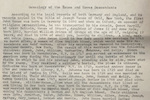

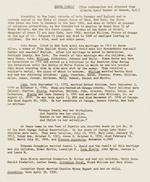
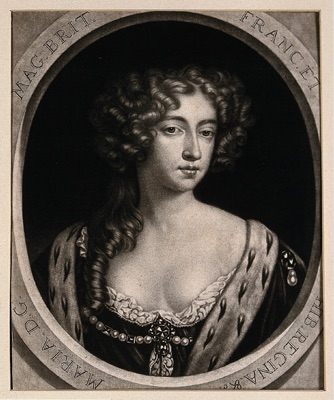
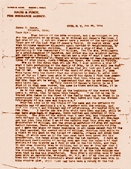
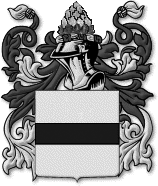
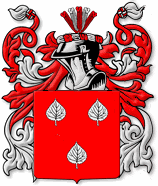
.gif)
